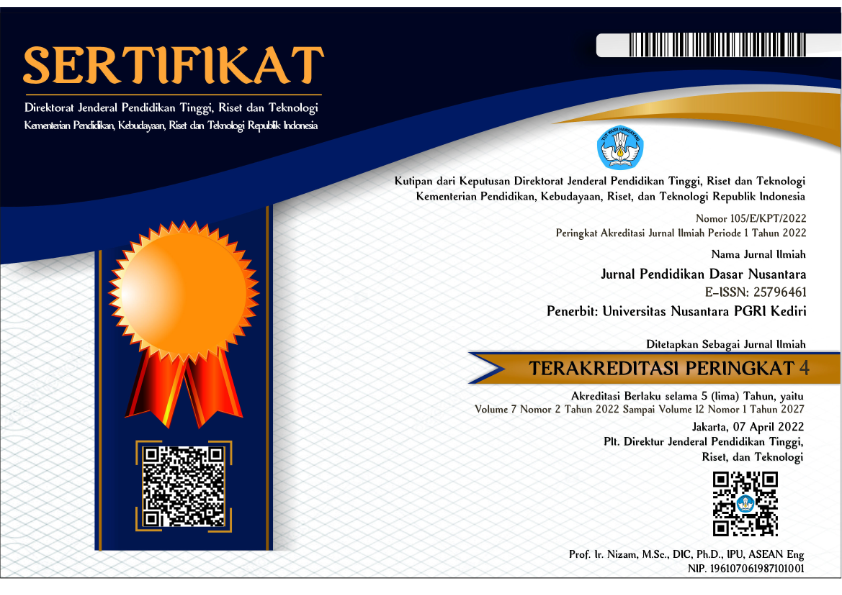PERBEDAAN METODE SCRAMBLE DENGAN METODE WORD SQUARE TERHADAP HASIL BELAJAR SISWA MATA PELAJARAN BAHASA INGGRIS MATERI PARTS OF HUMAN BODY
Studi pada Siswa Kelas III SDIT At-Taufiq Kota Tangerang
DOI:
https://doi.org/10.29407/jpdn.v3i2.11784Keywords:
Studi pada Siswa Kelas III SDIT At-Taufiq Kota TangerangAbstract
This study aims to determine differences in student learning outcomes in English subjects in two classes, with first experimental class using scramble method and second experimental class using word square method. This type of research is quantitative research with quasi experiment type. In this research the sampling technique using saturated sampling technique. The sample in this research is the students of class IIIA and students of class IIIB at SDIT At-Taufiq Tangerang City. Instruments in this study using objective tests in short form. Based on the calculation using t-test, it is found that t-count > t-table (3,1> 2,011) at significant level α = 0,05. The average score in experimental class I using scramble method is 69.58 and the average score in experiment class II using word square method is 78.2. So the word square method is better than scramble method.
Keywords: scramble method, word square method, student learning outcomes
Downloads
References
Kurniasih, I & Sani, B. (2016). Ragam Pengembangan Model Pembelajaran Untuk Peningkatan Proferionalitas Guru. Surabaya: Kata Pena.
Mukrima, S. S. (2014). 53 Metode Belajar dan Pembelajaran. Bandung: Universitas Pendidikan Indonesia.
Peraturan Pemerintahan No 19 Tahun 2005. (Mei 2005) diakses dari http://www.peraturan.go.id
Pribadi, B. A. (2011). Model Assure untuk Mendesain Pembelajaran Sukses. Jakarta: PT. Dian Rakyat.
Rusman. (2015). Pembelajaran Tematik Terpadu. Jakarta: Pt Rajagrafindo Persada.
Shoimin, A. (2014). 68 Model Pembelajaran Inovatif dalam Kurikulum 2013. Depok: Ar - Ruzz Media.
Slameto. (2013). Belajar dan Fakto-fakto yang Mempengaruhi, Edisi Revisi. Jakarta: Pt Rineka Cipta.
Sugiyono. (2016). Metode Penelitian, Kunatitatif, Kualitatif, dan R&D. Bandung: Alfabeta.
Suprijono, A. (2009). Cooperative Learning Teori dan Aplikasi Pikem. Yogyakarta: Pustaka Pelajar.
Susanto, A. (2012). Teori Belajar & Pembelajaran di Sekolah Dasar. Jakarta: Kencana Prenada Media Group.
Suyatno, K. K. (2015). English For Young Learning . Jakarta: Bumi Aksara.
Djamarah, S. B. & Zain, A. (2015). Strategi Belajar Mengajar, Edisi Revisi. Jakarta: Rineka Cipta.
Taufiq, M. (2013). Pengantar Psikologi. Yogyakarta: Smart Writing.
Downloads
Published
Issue
Section
License
Authors who publish with this journal agree to the following terms:
- Copyright on any article is retained by the author(s).
- The author grants the journal, the right of first publication with the work simultaneously licensed under a Creative Commons Attribution License that allows others to share the work with an acknowledgment of the work’s authorship and initial publication in this journal.
- Authors are able to enter into separate, additional contractual arrangements for the non-exclusive distribution of the journal’s published version of the work (e.g., post it to an institutional repository or publish it in a book), with an acknowledgment of its initial publication in this journal.
- Authors are permitted and encouraged to post their work online (e.g., in institutional repositories or on their website) prior to and during the submission process, as it can lead to productive exchanges, as well as earlier and greater citation of published work.
- The article and any associated published material is distributed under the Creative Commons Attribution-ShareAlike 4.0 International License

































